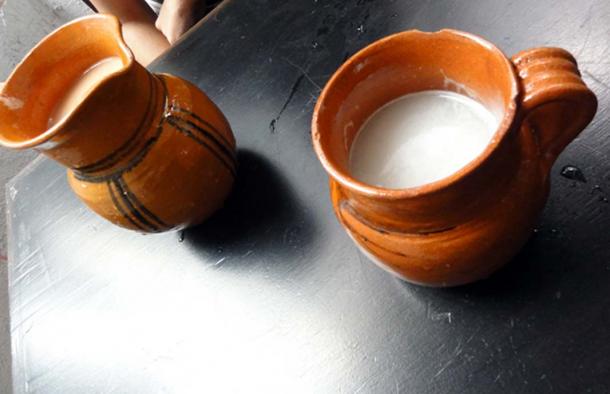
Mexico Sees Resurgence of Pulque, Ancient Alcoholic Beverage of Mesoamerica
Mexico is seeing a renewed interest in the traditional alcoholic beverage known as pulque, a milky drink made from the sap of the agave, whose origins go back thousands of years. Although the ancient drink cannot be canned or bottled due to its ongoing fermentation process, the drink is making a comeback among the younger generation of Mexicans in bars and ‘pulquerias’.
The Seattle Times reports that, although the tradition of drinking pulque had endured since ancient times, it went out of favour in the 1970s as it was seen as a “peasant’s drink”.
“Pulque long had a reputation as the drink of poor farmers and many assumed it was produced under unsanitary conditions,” says the Seattle Times. However, this view is now changing. “In areas around Tepotzotlan, pulque fanatics including farmers, growers and urban residents for the last three years have organized a sort of pulque caravan complete with food, horseback riding, music, pulque-drinking competitions and burros laden with wooden barrels of the beverage.”

Pottery vessels containing pulque (Omar Barcena / flickr)
Pulque is an alcoholic drink that is traditional to central Mexico. It has the colour of milk, somewhat viscous consistency and a sour yeast-like taste. The drink was considered sacred, and its use was limited to certain classes of people. There are many references in Aztec codices of pulque use by nobility and priesthood to celebrate victories. Among commoners, it was permitted only to the elderly and pregnant women. It was also drunk at rituals by priests and sacrificial victims, to increase the priests' enthusiasm and, supposedly, to ease the suffering of the victim.

‘The discovery of pulque’ by nineteenth-century Mexican painter José Obregón (CC by 2.0)
Various stories and myths have developed surrounding the origins of pulque. Most involve Mayahuel, the goddess of the maguey (agave plant). It was thought that the sap in the centre of the agave plant was her blood. The festivities celebrating Mayahuel, the deity of pulque, was one of the few occasions that drunkenness was allowed.

The goddess Mayahuel. Source: Wikipedia
A lot of information about pulque use has also been gained through the discovery of murals depicting its consumption. The most well-known mural, known as Los Bebedores or ‘The Drinkers’ , dates back 1,800 years and depicts a scene of drunken revelry as part of a pre-Hispanic ceremony dedicated to the goddess Mayahuel. The figures are engaged in various activities, including drinking, making offerings, serving, and even vomiting and defecating. They all appear to be in a state of intoxication. Measuring over 60 metres in length, it is one of the longest pre-Columbian murals found in Mexico.

Los Bebedores - The Mural of the Drinkers. Image source.
Prior studies have suggested that pulque may have played an important nutritional role, as well as a sacred and ritualistic one. The agave (maguey) plant from which the sap is extracted, survives frost and drought much better than maize, which was a key crop for the people of Teotihuacan. So when crops of maize were destroyed by difficult climate conditions, the pulque made from the agave could have provided vital calories, essential nutrients, and probiotic bacteria. Tequila is also made from agave plants, but this alcohol is made from the baked hearts of the plants, not the sap.
After the Spanish Conquest of Mexico, pulque became secular and its consumption rose, reaching its peak in the late 19th century. In the 20th century, the drink fell into decline, mostly because of competition from beer, which became more prevalent with the arrival of European immigrants. However, the latest resurgence in pulque drinking in Mexico means the ancient tradition will endure for many years to come.
Top image: ‘Drinking Pulque’ (Rory Finneren / flickr)
















Comments
It is very interesting that drinking this is becoming popular again, It tastes awful and is barely palatable and It is obviously not consumed for it’s flavor! In some circles Acacia is added during the making to add an additional Alkaloid kick to it.